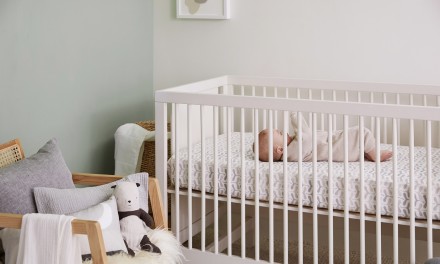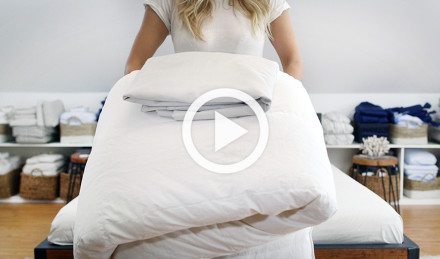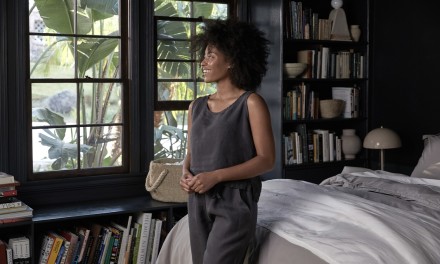Whether you have a little one on the way or are a new parent navigating the robust world of baby products, it can be tough to figure out not only what you need but also when.
Ensuring your bundle of joy gets plenty of shut-eye is a top priority — it helps them grow and helps you get your much-needed rest. But just as important as soothing your baby to sleep is making sure they're safe while they snooze.
Depending on your child's age, a swaddle, crib sheet, baby blanket and bed pillow might be part of the equation. If you're wondering whether your weeks or months-old baby can sleep with a newborn blanket or newborn pillow, the short answer is they can't. But that doesn't mean these items are off the table forever.
So then, when can your tiny tot snuggle up with a baby pillow or quilt at night? Read on for answers to these questions, along with useful insight into the best bedding, towels and other baby essentials.
When Can a Baby Sleep With a Blanket?
When is it considered safe for a child to have a baby blanket in their crib? According to the American Association of Pediatrics (AAP), infants should sleep without a blanket until they're at least 12 months old to reduce the risk of accidental suffocation.¹
Soft baby blankets are certainly cute and snuggly, and you might be tempted to offer one to your little one at bedtime or naptime. While they seem harmless enough, the reasoning is that loose fabrics can become twisted and ruffled, potentially covering an infant's nose and mouth while dozing.
All you need in the crib those first 12 months is a crib sheet. Don't worry, though, because you can ensure your baby is plenty cozy and warm with pajamas and a swaddle. It might seem odd to forgo bed covers and place your baby in the middle of an otherwise empty crib, but your child won't miss the other items because, well, it's all they know.
What Is a Baby Blanket?
A baby blanket is essentially a small, soft blanket. Since infants aren't supposed to sleep with them, it's understandable to wonder what exactly they're for. Baby blankets have lots of uses, including a nursing cover, a layer of warmth in the car seat or stroller, a cozy wrap or a diaper-changing surface in a pinch.
When Can a Baby Sleep With a Blanket?
When is it considered safe for a child to have a baby blanket in their crib? According to the American Association of Pediatrics (AAP), infants should sleep without a blanket until they're at least 12 months old to reduce the risk of accidental suffocation.¹
Soft baby blankets are certainly cute and snuggly, and you might be tempted to offer one to your little one at bedtime or naptime. While they seem harmless enough, the reasoning is that loose fabrics can become twisted and ruffled, potentially covering an infant's nose and mouth while dozing.
All you need in the crib those first 12 months is a crib sheet. Don't worry, though, because you can ensure your baby is plenty cozy and warm with pajamas and a swaddle. It might seem odd to forgo bed covers and place your baby in the middle of an otherwise empty crib, but your child won't miss the other items because, well, it's all they know.
What Is a Baby Blanket?
A baby blanket is essentially a small, soft blanket. Since infants aren't supposed to sleep with them, it's understandable to wonder what exactly they're for. Baby blankets have lots of uses, including a nursing cover, a layer of warmth in the car seat or stroller, a cozy wrap or a diaper-changing surface in a pinch.
Baby Blanket Sizes: Why Small Blankets Are Recommended for Babies
For your kiddo's first birthday, you can give them some cozy gifts like a baby blanket or quilt for sleeping. Since they're made for tiny humans, baby quilt sizes are substantially smaller than regular-sized blankets. The smaller sizing minimizes the amount of fabric while making the product less heavy overall, thus reducing the chance of suffocation.
Baby blanket dimensions are typically about 38 x 32 inches for infants or roughly 50 x 36 inches for toddlers. Swaddle blankets and receiving blankets are usually square, ranging from 40 x 40 inches to 48 x 48 inches. Conversely, a throw is closer to 50 x 70 inches, and regular quilts often come in adult bedding sizes.
Get more specific details about how bed covers are sized in our Guide to Quilts, Blankets and Coverlets: A Modern Take on Traditional Covers.
When Can a Baby Use a Crib Mattress?
Now that you're up to speed on when your child can use a baby blanket, you might be wondering when they can sleep on a crib mattress. Infants can actually sleep in cribs right away, though many parents start them in bassinets and then transition them to the crib at about three months.
As long as you use a flat, firm crib mattress with a fitted crib sheet and don't place any additional items inside, like a baby pillow, quilt or stuffed animals, you can rest assured your little one will sleep safely.
Since the launch of the Back to Sleep campaign in the 90s, the general consensus has been that newborns should sleep on their backs on a flat surface both at night and during naps.² Then when your infant begins to roll over at around the six-month mark, you can let them fall asleep on their tummy or side — or at least, you don't have to turn them over if they roll to that position.
For more guidance on keeping your child safe and healthy while they slumber, check out our article on Healthy Sleeping Habits for Babies.
When Can a Baby Sleep With a Pillow?
Is it considered safe for a child to have a baby pillow in their crib? The AAP says it's best to hold off on offering a baby sleeping pillow, as the soft, squishy material can be a safety hazard until a certain age.
So then, when can a toddler have a pillow? According to the AAP, you should wait until age two to minimize suffocation risk,³ at which point it's more of a toddler pillow.
When Can a Baby Sleep With a Pillow?
Is it considered safe for a child to have a baby pillow in their crib? The AAP says it's best to hold off on offering a baby sleeping pillow, as the soft, squishy material can be a safety hazard until a certain age.
So then, when can a toddler have a pillow? According to the AAP, you should wait until age two to minimize suffocation risk,³ at which point it's more of a toddler pillow.
Toddler Pillow Age
Of course, you want your growing tot to be as comfy as possible while they sleep. But as with bed covers, children don't miss what they've never had — and most don't even want to sleep with a pillow until they're at least 24 months old.
Many parents let their young children decide if and when to begin sleeping with a pillow, while others place one in after two years and allow them to naturally gravitate toward it. Still, between ages one and two, you'll want to limit your child's bedding to just a crib sheet and potentially a small blanket.
For more details about different types of sheets, see our guide, How to Pick Bed Sheets Based on How You Sleep.
What Is a Baby Pillow?
A baby pillow is basically an infant-sized pillow, though newborn sleeping pillows aren't really a thing. When people talk about a newborn baby pillow for a crib or bassinet, they might be referring to a baby head pillow — a donut-shaped cushion designed to correct flat head syndrome. However, the AAP still recommends skipping all pillows until the two-year mark.
Practicing tummy time during the day can help improve flat head syndrome⁴. And when your baby begins to roll over while sleeping, any flatness on the back of the head will likely resolve on its own.
Baby Pillow Sizes: Why Small Pillows Are Recommended for Toddlers
As with baby blankets, toddler pillows are sized accordingly. Baby pillow dimensions are usually 12 x 18 inches, just over half the size of a standard bed pillow (20 x 26 inches).
Large plush pillows aren't considered safe for littles younger than two or three because the excess material could obstruct breathing. In the end, small children simply don't need adult-sized pillows, plus the compact size fits neatly in a toddler bed or crib.
Read these articles to learn more about the various types of bed pillows:
The Best Baby Pillow and Baby Blanket Materials
What are the best materials for baby blankets? And what about toddler pillows? Find a breakdown of the various textiles and fill materials below.
The Best Baby Pillow and Baby Blanket Materials
What are the best materials for baby blankets? And what about toddler pillows? Find a breakdown of the various textiles and fill materials below.
Best Baby Blanket Materials
When it comes to baby bedding, the softer and more breathable, the better. Whether you opt for a waffle weave or cloud quilting, a cotton baby blanket is an excellent choice, as the natural textile allows air to pass through.
Linen is also known for being exceptionally breathable, and the flax-sourced fabric gets softer with every wash. But perhaps the softest, snuggliest option of all is cashmere, which is woven from the fibers found in the undercoats of pashmina goats.
What about the crib sheet? Ultra-soft brushed cotton, increasingly soft linen, cool-to-the-touch percale and anything else made of long-staple cotton is an excellent pick.
For a deeper dive into the various textile options for baby bedding, read these Parachute fabric guides:
Fabric and Bedding Materials Guide
Brushed Cotton: Know Your Bedding Like a Designer
Linen: Know Your Bedding Like a Designer
Percale: Know Your Bedding Like a Designer
Best Toddler Pillow Materials
Like blankets, breathability is key for pillows. Hypoallergenic materials are also recommended, such as a down alternative fill with a lightweight cotton shell. Quilted linen, cloud cotton and standard-weave cotton are great choices for pillowcases or shams.
A soft baby pillow may be best reserved for a child over the age of two, as the squishiness could pose a safety risk. When you first introduce a pillow, it might be wise to choose something a bit firmer.
See what went into the design and curation of our baby bed linens in our article, The Baby Collection: Behind the Design.
Caring for Baby Bedding and Towels
Before the age of two, your baby's skin is about 20% thinner than that of an adult.⁵ What does this have to do with caring for your little one's linens? Well, thinner skin is also more sensitive, so you'll want to reach for a mild, preferably unscented laundry detergent. Additionally, a natural formula might be best for safeguarding their delicate skin from rash or irritation.
Besides the type of laundry soap you use, regularly cleaning your child's crib sheet and any other bedding can help keep skin irritation at a minimum. Late-night spit-ups and diaper leaks aside, it's best to wash their bedding at least once a week.
To that end, machine-washable materials like cotton, linen and down alternatives are ideal. Wool dryer balls can help speed up the drying time and make your child's bed linens extra fluffy.
Check out the following articles for more insight into washing and caring for bedding and inserts:
How to Wash and Care for Bedding
Do Dryer Balls Really Work? Everything You Need to Know
How Often to Replace Sheets, Pillows and Other Bed Linens
Why Use a Natural Laundry Detergent? Your Questions Answered
Other Baby Textiles and Products to Consider
What else do you need besides a crib sheet and eventually a blanket and pillow? Baby essentials vary depending on who you talk to, though there are a few items you'll almost certainly need on a regular basis.
In the textiles category, this includes burp cloths, cloth bibs, swaddle blankets, washcloths and maybe an on-the-go travel changing pad. You'll also want to have at least a few sets of snuggly yet breathable pajamas and a stuffed animal or two — just keep the stuffies out of the crib until at least 24 months. Lastly, a hooded baby towel is not only adorable but also perfectly lightweight and gentle.
For more recommendations on essential items, see our article, Can't Live Without: Parachute Moms Share Their Must-Have Baby Items.
What to Know About Hooded Baby Towels
A hooded baby towel is what it sounds like: a small bath towel with a hood attached. What's the point, you ask? It's all about keeping your tot's head warm and dry as you transition them from the tub to the changing table after a bath.
It's OK to dry off your baby with a regular towel, but there are several reasons to choose a hooded design. For one, standard towels are not only larger but also heavier than baby towels, and they might carry too much weight for your little one.
What's more, the specific size, lightweight fabric and hood are designed to accommodate a baby or toddler's sensitive skin and small stature. Like dressing your child in cozy PJs and wrapping them in a swaddle, the purpose of a hooded towel is to ensure they're warm and protected — and the cuteness doesn't hurt either.
Check out these guides for more on the benefits of baby towels, how they compare to adult bath sheets, and how to care for high-end towels:
What are the Best Towel Materials and What Sizes Should You Buy?
Where to Buy the Best Baby Linens
Getting your child to rest safely and soundly is a top priority, and it starts with creating the right sleeping environment. If you're looking for high-quality bedding for your baby or are shopping for a loved one who has a little one on the way, you've come to the right place. Parachute has all the best nursery linens and then some.
We're talking crib sheets, baby blankets, quilts, toddler pillowcases and shams, along with hooded towels, washcloths, bibs, burp cloths, muslin swaddles, changing pads and cuddly stuffed bears and giraffes.
Browse the baby collection today!
External Sources:
1. https://pediatrics.aappublications.org/content/138/5/e20162938
2. https://safetosleep.nichd.nih.gov/safesleepbasics/moments/1994-2003
3. https://www.aappublications.org/content/aapnews/28/3/25.4.full.pdf
5. https://onlinelibrary.wiley.com/doi/full/10.1111/j.1468-2494.2010.00611.x
Where to Buy the Best Baby Linens
Getting your child to rest safely and soundly is a top priority, and it starts with creating the right sleeping environment. If you're looking for high-quality bedding for your baby or are shopping for a loved one who has a little one on the way, you've come to the right place. Parachute has all the best nursery linens and then some.
We're talking crib sheets, baby blankets, quilts, toddler pillowcases and shams, along with hooded towels, washcloths, bibs, burp cloths, muslin swaddles, changing pads and cuddly stuffed bears and giraffes.
Browse the baby collection today!
External Sources:
1. https://pediatrics.aappublications.org/content/138/5/e20162938
2. https://safetosleep.nichd.nih.gov/safesleepbasics/moments/1994-2003
3. https://www.aappublications.org/content/aapnews/28/3/25.4.full.pdf
5. https://onlinelibrary.wiley.com/doi/full/10.1111/j.1468-2494.2010.00611.x







